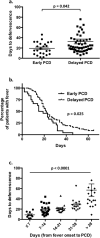Early percutaneous catheter drainage in protecting against prolonged fever among patients with pyogenic liver abscess: a retrospective cohort study
- PMID: 35975970
- PMCID: PMC9387318
- DOI: 10.1080/07853890.2022.2110612
Early percutaneous catheter drainage in protecting against prolonged fever among patients with pyogenic liver abscess: a retrospective cohort study
Abstract
Background: Percutaneous catheter drainage (PCD) has been viewed as first-line treatment for pyogenic liver abscess (PLA), yet detailed guidance is lacking for best practice of PCD. This study investigated characteristics of patients with PLA who had received PCD, identified factors associated with prolonged fever, and aimed to evaluate the relationship between timing of PCD and clinical improvement.
Methods: This was a retrospective study of patients with PLA who had undergone PCD over a 7-year period. PCD performed when the liquefaction degree of abscesses was less than 30% and/or within 1 week after fever onset was defined as early PCD. Patients were grouped and analysed based on the timing of PCD (early vs. delayed). Factors associated with prolonged fever were also analysed using univariate and multivariate logistic regression.
Results: Among 231 patients with PLA, 81 treated with PCD were included in the study after exclusion. The size of abscesses ranged from 3.4 to 16 cm in diameter. Interestingly, the abscesses were predominantly multiloculated in this cohort (82.7%). The most common pathogen isolated from pus was Klebsiella pneumoniae (60.5%), followed by Escherichia coli (8.6%). The duration of fever was significantly shortened with early PCD as compared to delayed PCD intervention (p = .042). No statistical differences were found between the two groups with regard to catheter adjustment and salvage drainage. Maximum body temperature and diameter of abscess > 7.5 cm were found to be associated with prolonged fever while early PCD was inversely related to prolonged fever. Multivariate analysis suggested that early PCD treatment was an independent protective factor of prolonged fever (p = .030).
Conclusions: Large abscesses with loculation could be successfully treated with PCD, and early PCD protected patients with PLA from prolonged fever. Our findings suggest that early intervention should be provided if PCD is indicated in clinical practice.KEY MESSAGESLarge abscesses and multiloculated abscesses can be treated with percutaneous catheter drainage.Early percutaneous catheter drainage is identified as a protective factor of prolonged fever among patients with pyogenic liver abscesses.Early intervention should be provided if percutaneous catheter drainage is indicated for pyogenic liver abscesses.
Keywords: Percutaneous catheter drainage; early; loculation; prolonged fever; pyogenic liver abscess.
Conflict of interest statement
No potential conflict of interest was reported by the author(s).
Figures


Similar articles
-
Factors associated with treatment failure of percutaneous catheter drainage for pyogenic liver abscess in patients with hepatobiliary-pancreatic cancer.Am J Surg. 2013 Jan;205(1):52-7. doi: 10.1016/j.amjsurg.2012.03.006. Epub 2012 Jul 12. Am J Surg. 2013. PMID: 22794706
-
Liver Abscesses: Factors That Influence Outcome of Percutaneous Drainage.AJR Am J Roentgenol. 2017 Jul;209(1):205-213. doi: 10.2214/AJR.16.17713. Epub 2017 May 15. AJR Am J Roentgenol. 2017. PMID: 28504550
-
Maximal diameter of liver abscess independently predicts prolonged hospitalization and poor prognosis in patients with pyogenic liver abscess.BMC Infect Dis. 2021 Feb 11;21(1):171. doi: 10.1186/s12879-021-05873-7. BMC Infect Dis. 2021. PMID: 33573593 Free PMC article.
-
Percutaneous transthoracic catheter drainage for lung abscess: a systematic review and meta-analysis.Eur Radiol. 2022 Feb;32(2):1184-1194. doi: 10.1007/s00330-021-08149-5. Epub 2021 Jul 29. Eur Radiol. 2022. PMID: 34327579
-
Percutaneous catheter drainage versus percutaneous needle aspiration for liver abscess: a systematic review, meta-analysis and trial sequential analysis.BMJ Open. 2023 Jul 30;13(7):e072736. doi: 10.1136/bmjopen-2023-072736. BMJ Open. 2023. PMID: 37518084 Free PMC article.
Cited by
-
Demographics and Clinical Outcomes of Culture-Positive versus Culture-Negative Pyogenic Liver Abscess in an Asian Population.Infect Drug Resist. 2023 Feb 16;16:903-911. doi: 10.2147/IDR.S395428. eCollection 2023. Infect Drug Resist. 2023. PMID: 36814829 Free PMC article.
-
Liver abscess due to Granulicatella adiacens in an immunocompetent patient: Case report.Biomedica. 2023 Mar 30;43(1):22-26. doi: 10.7705/biomedica.6504. Biomedica. 2023. PMID: 37167469 Free PMC article.
-
Clinical application of ultrasound-guided surgical puncture and drainage in early treatment of pyogenic liver abscess.World J Gastrointest Surg. 2025 Jul 27;17(7):107544. doi: 10.4240/wjgs.v17.i7.107544. World J Gastrointest Surg. 2025. PMID: 40740910 Free PMC article.
-
Retrospective comparative analysis of human fascioliasis versus bacterial liver abscess.Medicine (Baltimore). 2024 Dec 13;103(50):e40914. doi: 10.1097/MD.0000000000040914. Medicine (Baltimore). 2024. PMID: 39686435 Free PMC article.
-
Clinical efficacy of ulinastatin in the treatment of unliquefied pyogenic liver abscess complicated by septic shock: A randomized controlled trial.Immun Inflamm Dis. 2023 Apr;11(4):e822. doi: 10.1002/iid3.822. Immun Inflamm Dis. 2023. PMID: 37102655 Free PMC article. Clinical Trial.
References
-
- Mc FA, Chang KP, Wong CC.. Solitary pyogenic abscess of the liver treated by closed aspiration and antibiotics; a report of 14 consecutive cases with recovery. Br J Surg. 1953;41(166):141–152. - PubMed
-
- Tazawa J, Sakai Y, Maekawa S, et al. . Solitary and multiple pyogenic liver abscesses: characteristics of the patients and efficacy of percutaneous drainage. Am J Gastroenterol. 1997;92(2):271–274. - PubMed
-
- Harclerode TP, Gnugnoli DM.. Percutaneous abscess drainage. Treasure Island (FL): StatPearls; 2021. - PubMed
Publication types
MeSH terms
LinkOut - more resources
Full Text Sources
